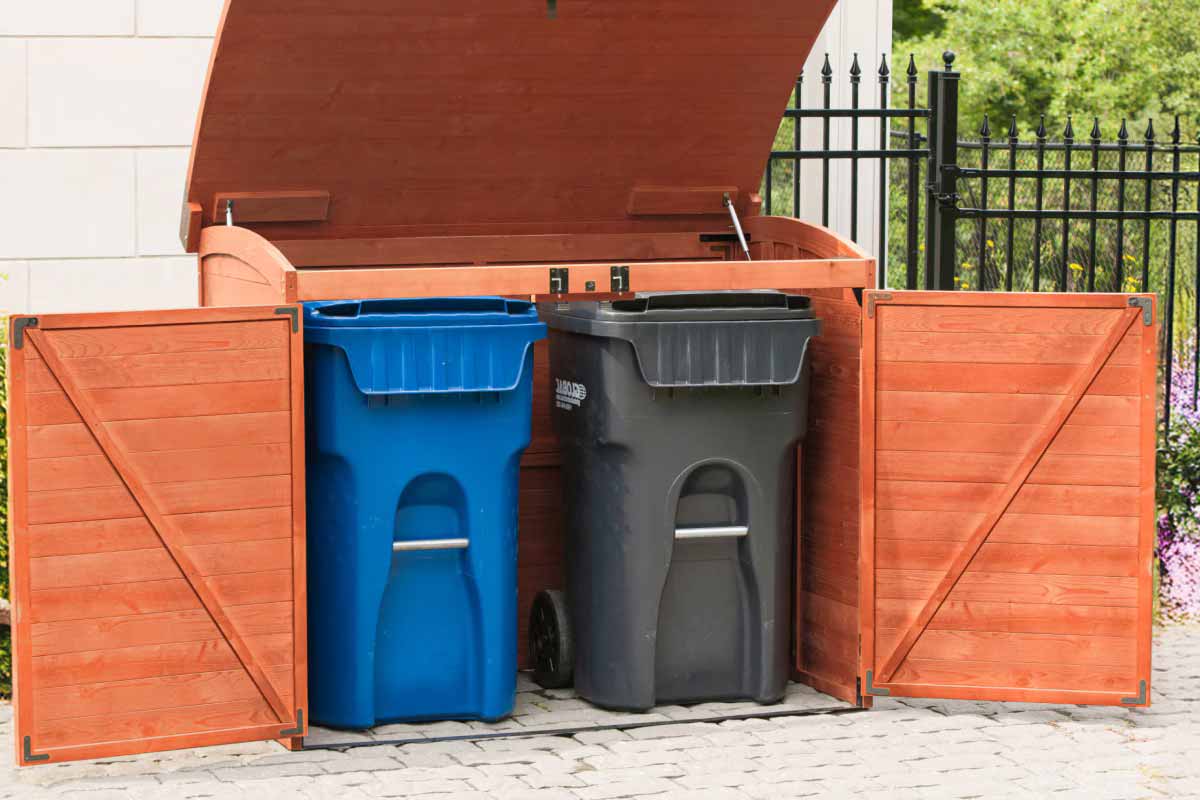Those bins by the garage draw attention for the wrong reasons. A clean fix looks good and works every day. Build a compact corral that tucks trash cans out of sight while keeping them handy for pick-up. The enclosure softens color contrast, limits odor drift, and deters pests. Prebuilt models average about $300, so a tailored DIY may cut costs. Choose materials that match your home, then size the nook to your pathway. You gain calm lines, plus smoother weekly routines.
Why a compact corral transforms curb appeal fast
A corral gives bins a defined home, so your façade stays tidy. It frames the service area, while the side yard remains open and easy. Because it screens trash cans, the front approach feels cohesive, not cluttered. The fix is quick to use, and it respects tight spaces.
Good screening improves more than looks, since it shapes movement. The lid lifts without scraping shrubs, and the wheels roll straight. Neighbors see finished details rather than plastic. The enclosure becomes a quiet backdrop, so paint and planting stand out. Your walkway reads wider because edges stay clean.
Protection matters as much as appearance, because weather is relentless. Panels buffer gusts, yet allow airflow that helps odors dissipate. Simple latches discourage rummaging. A fitted layout limits tipping, since posts hold strong lines. You get order on busy mornings, and less mess after storms.
Build choices that suit style, budget, and daily use
Start with four 4×4 posts, six or eight feet long. Lattice brings lightness, while slat wood feels classic and calm. Vinyl panels stay low-maintenance, so paint work drops. One mention in each panel is enough: the enclosure exists for trash cans, not the other way around.
Pick rot-resistant wood like cedar, or pressure-treated stock. Then use exterior screws that grip well and weather hard. Post sleeves and caps slow moisture wicking, so end grain lasts longer. They are not fully waterproof, yet they help. Add lattice caps for a crisp, finished line.
Color ties everything together, because tone sets mood. Stain shows grain and blends with fencing. Paint can match trim, so the yard reads planned. Choose a calm hue that lowers contrast near the wall. The corral should recede, while your planting and door color shine.
Site prep and setting posts for a strong, square frame
Mark the footprint so doors open cleanly and wheels roll straight. A post hole digger makes neat holes, while edges stay firm. Dig about 36 inches deep and 9 to 12 inches wide. Keep posts taller than trash cans once placed, so lids clear and swing.
Mix cement to the bag’s ratio, then brace each post plumb. A simple stabilizer holds true while the mix cures. Fill the hole and dome the top for drainage. Check alignment as you go, because straight lines guide panels. Good bases prevent racking when winds rise.
After curing, fasten fencing to the posts. Pre-drill to avoid splits, and space boards for airflow. Gaps help odors vent while limiting views. Check level often, then adjust before final tightening. Hinges sit where reach feels natural. Handles land at a height that saves your back.
Finishing touches that improve function, durability, and flow
Post sleeves and caps sharpen edges, while they shed water. Lattice caps protect cut ends, so panels last longer. Paint or stain locks in tone, and it seals surfaces. Because sun fades finishes, choose products labeled exterior. Maintenance stays simple when you keep a small kit.
Underfoot matters, since wheels bear the load. A ribbon of concrete or a run of pavers reduces mud and pooling water. The surface stays firm through seasons, so bins glide in and out. Drainage lines move water away, while joints stay even. You gain clean shoes and cleaner wheels.
Details shape daily ease, because small choices add up. Keep a palm latch near the gate, so one hand opens quickly. Add a stopper that holds the door wide on pick-up morning. A narrow bumper protects siding from scuffs. Label positions, and trash cans return to their spots.
Rules, safety checks, and when to choose a prebuilt unit
Homes have limits, and some rules come first. Renters may need written approval, since exterior changes affect appearance. HOAs often review screens and enclosures, because streetscape matters. Ask before you build, and avoid surprise fines. When allowed, keep height and setback within posted guidelines near drives.
Call local utility services or check maps before any dig. Underground lines sit where you least expect them. Confirm routes, then mark clear zones with paint or flags. Safety prevents costly damage, and it protects crew and neighbors. Work slow around roots and drains, because shifts can crack surfaces.
Time and budget shape the choice as well. Prebuilt corrals average about $300, which suits some schedules. DIY can save money when materials are on hand, or skills are sharp. Compare warranties, then weigh style control. If speed wins this week, buy; if fit matters more, build around trash cans.
A clear path to a neater side yard that still works hard
When clutter fades, routines feel smoother and faster. A well-built corral hides trash cans, yet it keeps movement simple. The bin rolls out on firm ground, while panels stand straight. With posts set deep and finishes sealed, your screen lasts for years. The street view reads calm, and your mornings start cleaner.
